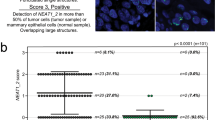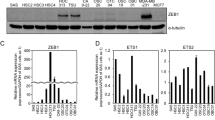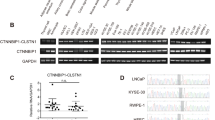Abstract
The ETS transcription factors are a large family implicated in the control of cellular proliferation and tumorigenesis. In addition, chromosomal translocations involving ETS family members are associated with a range of different human cancers. Given the extensive involvement of ETS factors in tumorigenesis, it becomes important to identify any additional ETS genes that may also play oncogenic roles. We identify a novel gene, ELF5, that appears to belong to the ELF (E74-like-factor) subfamily of the ETS transcription factor family, based upon similarity within the `ETS domain'. ELF5 displays a similar, but more restricted, expression pattern to that of the newly isolated epithelium-specific ETS gene, ELF3. Unlike most other ETS family members, ELF5 is not expressed in hematopoietic compartments, but is restricted to organs such as lung, stomach, kidney, prostate, bladder and mammary gland. ELF5 is localized to human chromosome 11p13–15, a region that frequently undergoes loss of heterozygosity (LOH) in several types of carcinoma, including those of breast, kidney and prostate. We find that ELF5 expression is not detectable in a number of carcinoma cell lines, some of which display loss or rearrangement of an ELF5 allele. Similar to other ETS family members, ELF5 displays specific binding to DNA sequences containing a GGAA-core. In addition, ELF5 is able to transactivate through these ETS sequences, present upstream from a minimal promoter. Our data suggest that ELF5 may play roles in mammary, lung, prostate and/or kidney function, and possibly also in tumorigenesis.
This is a preview of subscription content, access via your institution
Access options
Subscribe to this journal
Receive 50 print issues and online access
$259.00 per year
only $5.18 per issue
Buy this article
- Purchase on Springer Link
- Instant access to full article PDF
Prices may be subject to local taxes which are calculated during checkout
Similar content being viewed by others
Author information
Authors and Affiliations
Rights and permissions
About this article
Cite this article
Zhou, J., Ng, A., Tymms, M. et al. A novel transcription factor, ELF5, belongs to the ELF subfamily of ETS genes and maps to human chromosome 11p13–15, a region subject to LOH and rearrangement in human carcinoma cell lines. Oncogene 17, 2719–2732 (1998). https://doi.org/10.1038/sj.onc.1202198
Received:
Revised:
Accepted:
Published:
Issue Date:
DOI: https://doi.org/10.1038/sj.onc.1202198
Keywords
This article is cited by
-
The transcription factor ELF5 is essential for early preimplantation development
Molecular Biology Reports (2023)
-
ELF5 is a potential respiratory epithelial cell-specific risk gene for severe COVID-19
Nature Communications (2022)
-
Effect of the normal mammary differentiation regulator ELF5 upon clinical outcomes of triple negative breast cancers patients
Breast Cancer (2018)
-
Gene regulatory network underlying the immortalization of epithelial cells
BMC Systems Biology (2017)
-
Discovery of prognostic biomarkers for predicting lung cancer metastasis using microarray and survival data
BMC Bioinformatics (2015)



